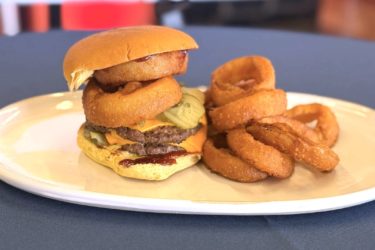The Local newsletter is your free, daily guide to life in Colorado. For locals, by locals.
It’s a windy March day, and Richard Pecoraro is loading clear plastic tubs crammed with bags of pea seeds onto his dirt-caked red tractor at Boulder County’s MASA Seed Foundation. He’s scrambling to get them in the ground at the 24-acre farm and nonprofit, where he serves as agricultural director, before a spring storm cloaks the Front Range in snow. Inside a barnlike structure nearby, assistant director Laura Allard packs jars with dried kernels of corn. To the untrained eye, this could look like any other family-run ag business operating along the Front Range. But there’s more than meets the eye here, and one need only peer inside the farm’s white clapboard house to see why.
There, hundreds of clear, lidded jars full of seeds line shelves on nearly every wall. The vessels are grouped by plant variety, from marigolds to grains to tomatoes and everything in between. These aren’t your run-of-the-mill garden starters, though. The seed collection is the heart of MASA (Mutual Admiration Seed Association), a nonprofit Pecoraro and Allard founded five years ago with a mission to build a bank of heirloom and native seeds adapted to the Centennial State’s unique soils and wild climate.
Pecoraro, 66, and Allard, 58, who are partners in life and in the field, grow roughly 1,000 types of vegetables, herbs, fruits, grains, legumes, and flowers every year. Like most agricultural operations, they sell their products to individual consumers and restaurants, but they also toil a little harder than most to harvest the seeds of the plants that perform best in the Front Range’s dry, windy, high-elevation conditions. The mightiest plant offspring are stowed in the clapboard seed house, but they don’t all remain there. Unlike facilities such as Fort Collins’ National Laboratory for Genetic Resources, which keeps more than 850,000 plant seeds and materials within secure concrete walls for posterity, MASA isn’t just a storage facility. It is also a seed retailer and farm. “Our seeds go back into the field every year,” Allard says, explaining that returning them to the soil gives them the opportunity to continue acclimating to the area’s mercurial weather.
Much of what Pecoraro and Allard do might appear to be playing in the dirt. For instance, along with staffers and volunteers, the couple once planted more than 50 types of sunflowers from around the world to discover the breeds that might thrive best here in Colorado. But they aren’t just experimenting for fun. Twelve of the 50—including the red-orange-hued Tithonia and eight-foot-tall Purple Mammoth—prospered particularly well and exhibited a wealth of positive traits, from tasty kernels to pretty petals, that could not only make MASA’s produce more compelling to prospective customers, but ideally also persuade Centennial State home gardeners to ditch the mass-produced seed packets sold at big-box stores in favor of the nonprofit’s bred-especially-for-Colorado seeds.
Seed collecting and breeding are not new endeavors. Centuries of immigration to the United States have brought non-native seeds to its soil. But for much longer, Indigenous peoples of the Americas have stewarded crops, such as peppers and tomatoes, many of which have formed lineages of heirloom seeds, often defined as seed varieties that are at least 50 years old and that have been grown and preserved for generations. Many are organic, which means they are produced without pesticides.
In the 1930s, however, hybrid seed, the result of deliberately cross-pollinating plants to generate greater yield and uniformity, rose in popularity over their heirloom counterparts. Industrial agriculture quickly capitalized on the high productivity of hybrid seed, but the widespread planting of it has diminished crop genetic diversity and contributed to the homogenization of global food systems.
In the 1970s, a movement that championed the saving and sharing of heirloom seeds—which, unlike hybrids, retain the genetic traits of their parent plants—blossomed among backyard gardeners and organic farmers. Despite their efforts to save certain seed types from extinction, hybrid seed has remained king. Here in Colorado, however, a handful of operations, including MASA, have recently taken on the challenge of regionally adapting seeds, including those from heirloom crops.
It takes a special level of attention to detail to collect seeds from crops that have favorable characteristics and grow them annually without the use of chemicals. But farmers like Dan Hobbs, who owns 24-year-old Pueblo Seed & Food Co. in Cortez with his wife, Nanna Meyer, believe the benefits are worth the extra effort.
Hobbs and Meyer opened a small storefront this past September in Cortez, where they stock bread, pantry items, and seeds, all derived from organic crops they’ve cultivated on their 30-acre farm. Over the years, Hobbs has sowed successions of one of Colorado’s most beloved ingredients, the Pueblo chile. When the 55-year-old started growing the pepper in 2009, he wasn’t picky about the plants from which he took seeds. Then, in 2017, he began to store seeds from shrubs that exhibited characteristics he wanted to replicate during future seasons: meaty flesh, a leafy canopy for summer heat protection, and bountiful fruit production.
Since then, his diligence has been rewarded at September’s Pueblo Chile Festival, where the peppers Pueblo Seed & Food Co. sells at its booth have been receiving increasing acclaim. “We’ve developed this little following of people that say, ‘This is the best chile we’ve ever had in our lives,’ ” he says. “So we’ve got all these dedicated customers that keep coming back.”
Flavor will always boost appeal, but Hobbs believes there are other upsides to carefully cultivated crops. A few years ago, Pueblo Seed & Food Co. started farming heirloom ancient and heritage grains, including maize, wheat, rye, barley, and millet. Hobbs sent samples of his maize to CIMMYT, an international wheat and maize foundation that works to strengthen the world’s food systems, and learned that his crop had impressive nutritional value, such as high levels of iron, that newer genetically modified or hybrid varieties sometimes don’t. “In the pursuit of a good-looking plant or a high-yielding plant, certain traits get sacrificed,” Hobbs says. “One great example is that a lot of these modern wheats are extremely low in fiber.”
Laura Parker, 38, a self-proclaimed seed freak who worked on Hobbs’ farm in the early 2000s before starting High Desert Seed & Gardens in 2015 in Montrose, agrees that there are myriad benefits to selecting seeds for regional resiliency. “It’s like being a plant Jedi, really,” Parker says. “You’re observing the nuances and drawing potential genetic traits out and looking for that potential over time.” In 2022, she relocated her plot to Paonia, where she now grows roughly 1,000 varieties of plants each season on up to eight acres and sells 200 to 250 options that are well-adapted to the region’s hot summers and cold winters. Seeds for her Italian mountain basil and Pomodoro Pizzutello Di Paceco tomatoes are crowd-pleasers that customers seek out for their productivity and flavor.
By purchasing products from local seed farmers instead of mass-manufactured packets sold by the Home Depots of the world, Colorado gardeners can be more certain that their harvests will thrive in Colorado’s climate and exhibit the qualities they want, according to 38-year-old Casey Piscura, owner of Wild Mountain Seeds in Carbondale. Whether customers are seeking carrots that will survive winter storage or sweeter tomatoes for summer salads, local seed breeders offer wider arrays of options. In fact, 12-year-old Wild Mountain sells more than 500 types of seeds to home gardeners, chefs, and small farms. Piscura has had success with characteristics as specific as squash that’s been raised to yield lots of large blossoms ideal for stuffing and a sweet onion that matures earlier than its peers. “We want to develop things that help small farmers differentiate themselves in the marketplace,” he says. “We select for flavor. We select for storage abilities. [We think about] what makes an onion the best onion it can be.”
Helping Coloradans raise hardier and tastier tomatoes isn’t the only goal for farmers such as Piscura, Hobbs, Parker, and MASA’s Allard and Pecoraro. Ultimately, they hope to bring the biodiversity that’s been lost due to modern agricultural methods back to the food system to ensure it can nourish future generations. That, however, is a lofty—and long-term—ambition that would require selling many more seeds to larger and larger farming operations. For Allard and Pecoraro specifically, that would require substantially expanding their small staff. “We need a bigger crew up here,” she says. “We just aren’t funded for that [right now].”
In the meantime, these seed whisperers believe the first step toward a more diverse food future is to educate everyday gardeners about the value of regionally adapted seeds and persuade locals to plant them. “A lot more people are growing seeds now than when we started, which is the best thing that could ever happen,” Pecoraro says. “Seeds belong in the hands of the people.”
In MASA’s clapboard seed house, the wood floor creaks under Allard’s feet as she assists her customers. A woman who lives nearby peruses the tomato seeds while Allard gives another customer recommendations for the best crops to sow before a spring snowstorm. Next door, trays of germinated seedlings blanket the greenhouse floor. About one-third of the healthy babies will be sold as starter plants to green-thumbed Front Rangers while the rest will be transplanted into MASA’s fields, where they will weather the elements. As the growing season progresses, the fittest will evolve, making the following year’s seeds even more prepared to thrive in Colorado fields and gardens.









